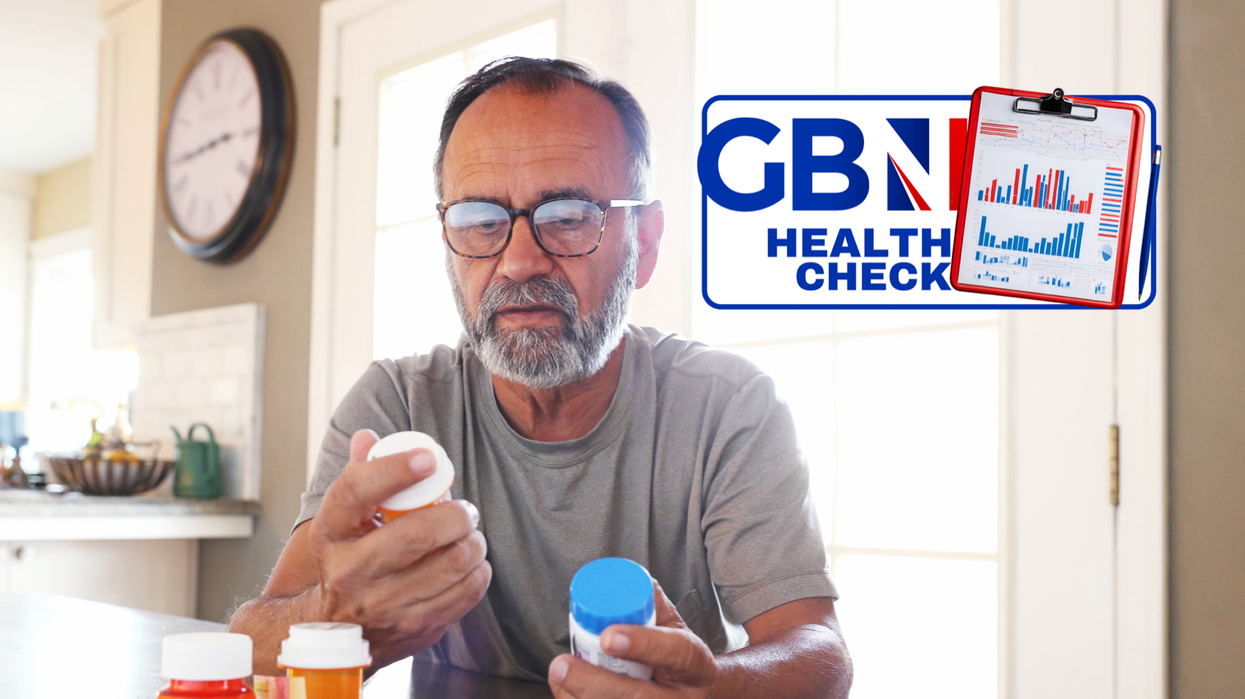GBN Health Check: HALF of Britons unaware of the eight common medicine combinations that can be 'deadly'

Half of Britons unaware of the side effects of the medicine combinations they take, horror new research reveals
|Getty Images

For this week's GB News Health Check, our Health Editor Adam Chapman speaks to pharmacists about the common medicine combinations that can prove life-threatening
Don't Miss
Most Read
Health experts have issued a warning to Britons who take multiple medications following findings that one in two are unaware of the potentially harmful side effects.
New data from TakingCare reveals that half of Britons are unaware of the side effects of the medicine combinations they take, with common medications for conditions such as high blood pressure, heart problems and blood sugar control all being identified as having potentially life-threatening side effects.
In light of the research, GB News asked Superintendent Pharmacist Carolina Goncalves of Pharmica for a run-down of the most "dangerous" combinations.
According to the pharmacist, "some dangerous combinations can affect a majority of people", she tells GB News.
Here are the worst culprits:
Blood thinners and NSAIDs
As the name suggests, blood thinners decrease blood viscosity and stop coagulation, preventing clots to treat conditions such as thrombosis (blood clots).
"The danger lies in combining blood thinners with nonsteroidal anti-inflammatory drugs (NSAIDs) like ibuprofen due to the way NSAIDs affect platelets," Ms Goncalves told GB News.
According to the pharmacist, platelets are critical for the formation of blood clots, so combining blood thinners with NSAIDs can significantly increase the risk of gastrointestinal bleeding.
Research reveals some horror stories. A meta-analysis published in the journal Thrombosis and Haemostasis concluded the risk of bleeding is "significantly increased" among persons taking warfarin - a commonly prescribed blood thinner - and NSAIDs compared with taking warfarin alone.
"It is important to caution patients about taking these medications in combination," the researchers wrote.
Blood thinners and antibiotics
Antibiotics work by killing bacteria or inhibiting their growth.
According to the online pharmacist, combining antibiotics with blood thinners like warfarin can "alter the metabolism of the blood thinner, increasing its potency and thus making it more likely for excessive bleeding to occur".
In one study, published in the American Journal of Medicine, patients on warfarin therapy exposed to high-risk antibiotics were 50 percent more likely to suffer serious bleeding events compared with patients on low-risk antibiotics, according to the study.
Notably, said the researchers, azithromycin - an antibiotic used to treat lung and chest infections - nearly doubled risk of serious bleeding events and trimethoprim-sulfamethoxazole (TMP-SMX) - used mainly to treat bladder infections -- was associated with a more than twofold increase in bleeding risk.
Many patients think drug interactions are only caused by pills, but topical antibiotics are absorbed into the bloodstream and can interfere with warfarin, too. This includes ointments, creams, and suppositories.
"A common cause of a rise in the INR is antifungal cream prescribed to women with a vaginal yeast infection," explained Massachusetts General Hospital's Lynn Oertel.
Doubling up on opioids
Opioid-based medicines such as diazepam are formulated to reduce pain perception. They often result in feelings of elation and pleasure, which is why they are highly addictive.
According to Ms Goncalves, taking more than one opioid together can result in "deadly effects because each opioid compound enhances the effects of the others, leading to excessive depression of the central nervous system".
She told GB News: "This can significantly decrease the respiratory rate to dangerously low levels, potentially resulting in respiratory arrest."
Combining opioids with benzodiazepines - a type of sedative medication used to treat anxiety and insomnia - can be particularly risky.
A U.S. Food and Drug Administration (FDA) review has found that the growing combined use of opioid medicines with benzodiazepines or other drugs that depress the central nervous system (CNS) has resulted in serious side effects, including slowed or difficult breathing and deaths.
Likewise, the Medicines and Healthcare Products Regulatory Agency - the UK's drug regulator - warns the combination of benzodiazepines and opioids can cause "respiratory depression", which can be fatal if not recognised in time.
Respiratory depression (hypoventilation) is when you breathe too slowly or too shallowly, leading to carbon dioxide building up in your blood (hypercapnia).
Calcium channel blockers and beta blockers
Calcium channel blockers are formulated to decrease the heart rate and dilate the arteries, thereby lowering blood pressure.
These effects can "compound" if calcium channel blockers are taken with beta-blockers, which are also designed to reduce heart rate and blood pressure by blocking the effects of the hormone epinephrine (adrenaline), warns Ms Goncalves.
"This can result in excessive reductions in heart rate and blood pressure," she told GB News.
According to the National Institute for Health and Care Excellence (NICE), verapamil - a commonly prescribed calcium blocker - should not be prescribed with a beta-blocker, as abnormally slow heart action, asystole (a condition where the heart ceases to beat), severe hypotension (abnormally low blood pressure), and heart failure can occur.
What else should you avoid?
Furosemide/indapamide
According to Peter Thnoia, Prescribing Pharmacist and the Chief Product and Innovation Officer at PillTime, combining furosemide and indapamide - medications used for heart conditions such as heart failure or high blood pressure - can cause rapid drops in blood pressure and require the patient to maintain a steady water intake.
“For example, if an elderly person taking one of these medications finds themselves sweating more than normal, they may quickly reach a state where their blood pressure is very low and which will drastically increase their chance of a fall," he warned.
Metformin and furosemide
Mr Thnoai explained: "Type 2 diabetes medication metformin can also cause a condition called lactic acidosis in cases where a patient becomes dehydrated. This can lead to them feeling exhausted, weak, experiencing a burning feeling in their muscles, as well as nausea, and cramps. It would be safe to say that an elderly person taking both metformin and furosemide are at increased risk if they become dehydrated, placing them more at risk of a fall.”
Antihistamines (Hay fever medication) and sedatives or benzodiazepines
As hay fever patients have suffered numerous ‘pollen bombs’ this summer, Peter warns that hay fever tablets should be taken with caution by patients who also take multiple other medications.
“Lots of the active ingredients of hay fever medication belong to a group of medicines called antihistamines,” Peter said, adding: “These are very effective in reducing symptoms of hay fever, however, they are known to cause drowsiness - some more than others.
“If someone is maybe not as steady on their feet and also taking another medication which has a sedative effect, alongside hay fever medication, they could quickly become at risk of a fall.
“Benzodiazepines such as temazepam, loprazolam, lormetazepam, diazepam and nitrazepam, which are typically prescribed to reduce anxiety and promote calmness, relaxation and sleep all include drowsiness and confusion as one of their potential side effects, so taking antihistamines in conjunction with these medications should also be handled carefully."
Oral decongestants (pseudoephedrine) and antidepressants
Peter highlights that antidepressants, which, according to the NHS are taken by 8.6million people in the UK, can also interact with common over-the-counter medicines and have potentially risky results.
“Selective serotonin reuptake inhibitors (SSRIs), which are used to treat depression and anxiety, can also cause drowsiness, confusion and slowing of reactions. Fluoxetine is a very well-known SSRI. Other SSRIs include citalopram (Cipramil), escitalopram (Cipralex), paroxetine (Seroxat) and sertraline (Lustral)," he explained.
According to pharmacist , another medication found in cold and flu products will interact with some antidepressants. For example, taking a selective SSRI antidepressant and an oral decongestant (such as pseudoephedrine or phenylephrine) can cause irritability, insomnia and affect blood pressure. If someone is unaware to look out for these they can display very odd behaviour that can be alarming for the individual and those around them.”
LATEST DEVELOPMENTS
Who is most at risk?
Data from TakingCare reveals the average 70-year-old in the UK takes around eight medications a day, so elderly people are particularly at risk of facing severe side effects.
In response to the findings, Lauren Frake, Elderly Care Expert at TakingCare, said: “Our experience with elderly people shows that people who experience confusion and delayed reactions are at a higher risk to themselves. This can mean they will put themselves in unnecessary risk because they haven’t understood their surroundings, or in more severe cases, they may neglect an injury or wound, which can lead to dangerous consequences. This could be even riskier for those with Dementia or Alzheimer’s.
“Emergency alarm services will help to monitor patients who take multiple medications, and response teams will be on the lookout for common side effects, and it’s important that family members are also aware of potential side effects and the signs to look out for.
“For example, patients who are suffering from sudden confusion as a result of their medication may be unnaturally irritable and perhaps even aggressive. They will likely have changes in their personality, may have rambled speech and seem easily distracted from the conversation.
“Special care should be taken around people who are expressing these symptoms, as they may be at risk of an accident, so ensure the home space has been checked for any trip hazards or poor lighting in stairwells. It may sound simple, but a quick check to make sure corners of rugs are taped down and that there are non-slip mats in the bathroom areas and kitchens can make all the difference for preventing accidents at home.
“Whilst an increased risk of falling may be alarming to the families of patients who are unaware of this information, the key takeaway is that there are simple preventative measures that can be put in place to reduce the risk of patients having a fall. By taking simple preventative steps early on, both patients and their families and ensure that elderly people can live independently and safely at home for longer.”










